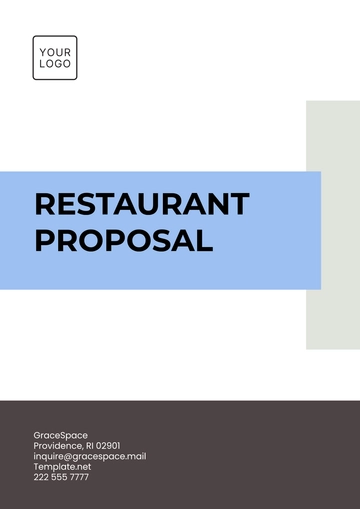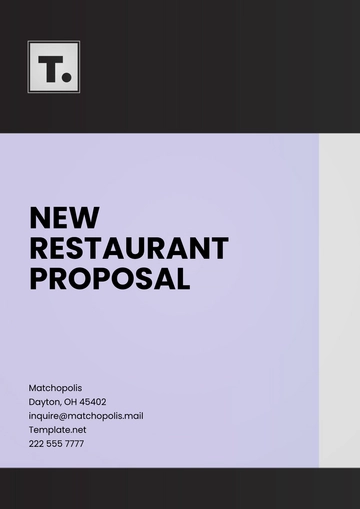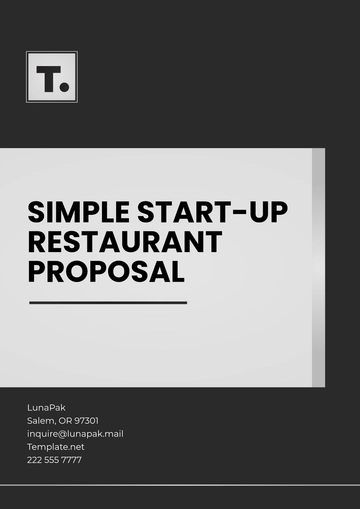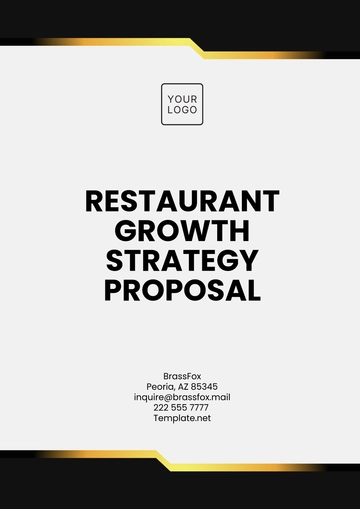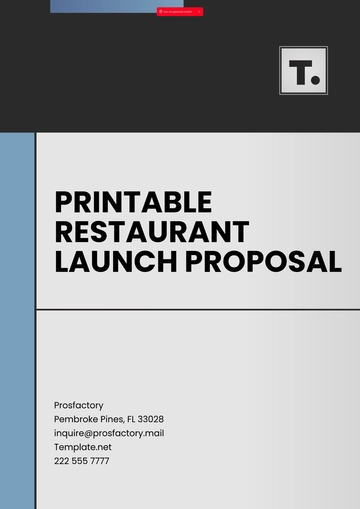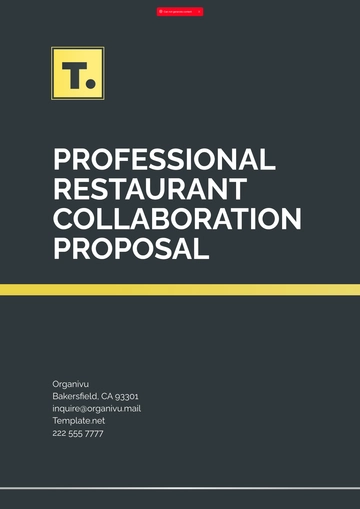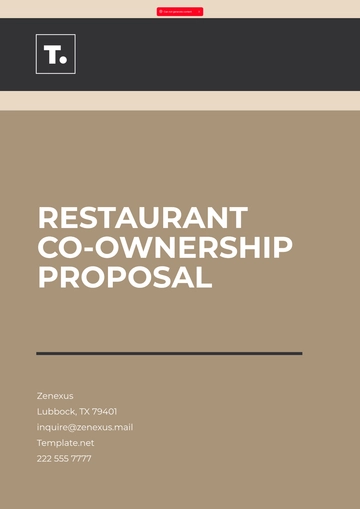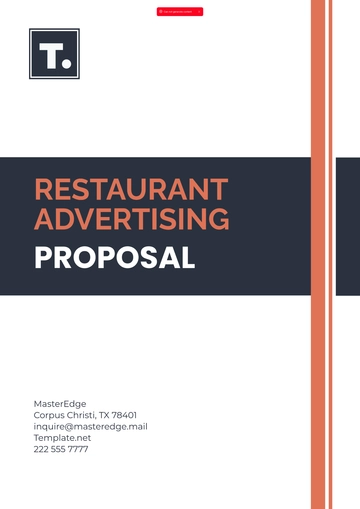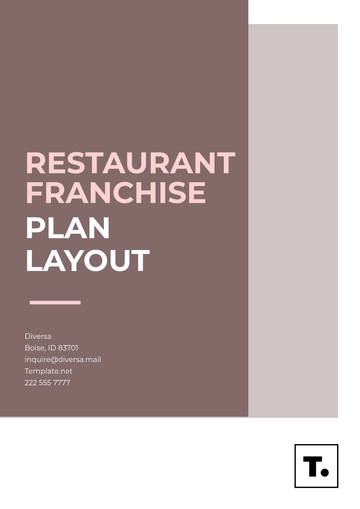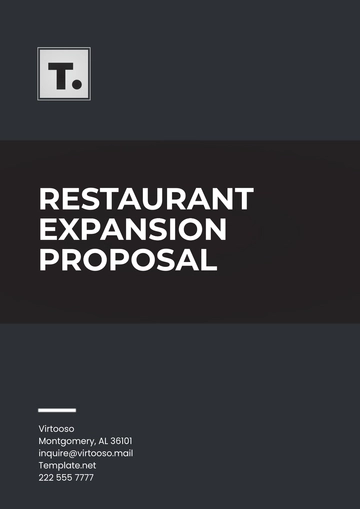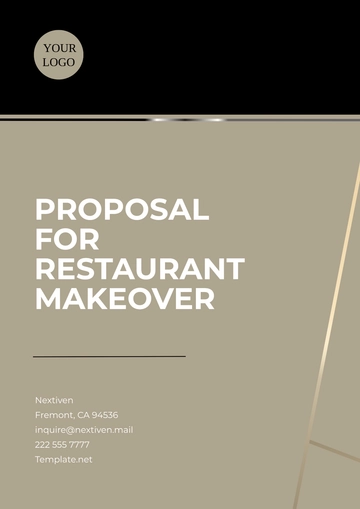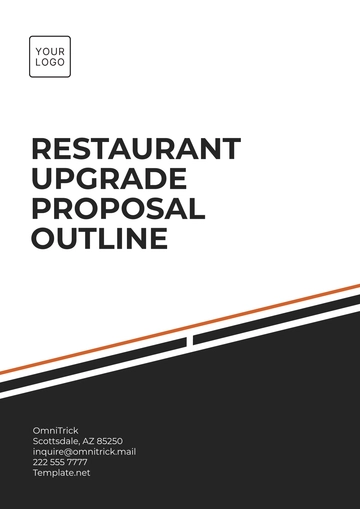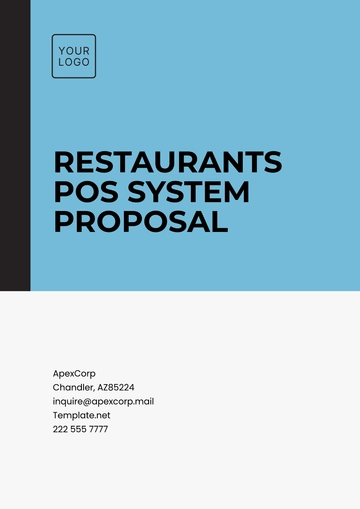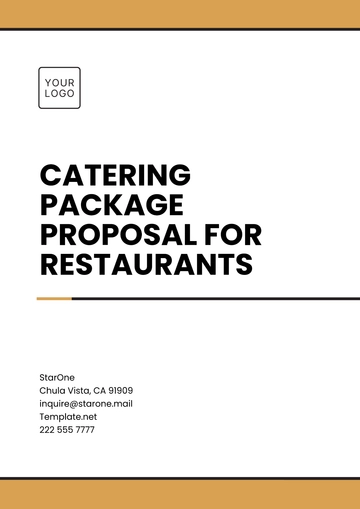Free Sushi Restaurant Business Proposal
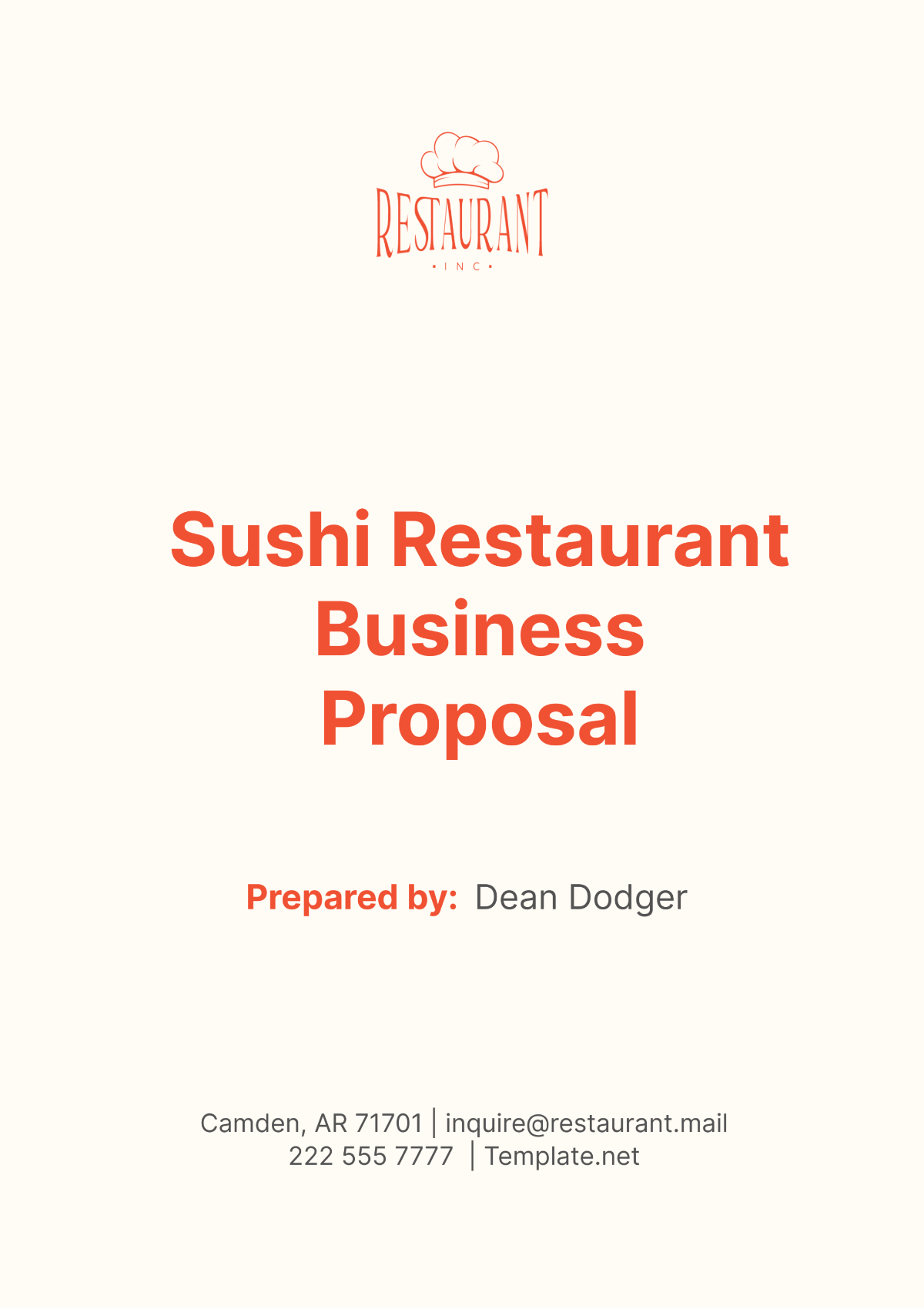
I. Executive Summary
The goal of this proposal is to outline a strategic plan for launching or expanding [Your Company Name]'s sushi restaurant venture. Recognizing the growing demand for authentic and innovative sushi dining experiences, this document will serve as a platform to attract significant investment and partnerships required to realize the vision. Detailing the unique offerings and competitive advantages of our sushi restaurant, this proposal underscores our commitment to excellence in quality and customer service.
[Your Company Name] plans to launch a distinctive sushi restaurant that caters to both traditional and contemporary tastes, setting a new standard in the culinary scene. Our menu will feature a blend of classic sushi and sashimi alongside innovative dishes that incorporate local flavors and modern gastronomy techniques. This approach not only satisfies purists but also attracts a broader audience seeking a unique dining experience. The executive team, with extensive experience in high-end Japanese cuisine, is committed to maintaining the highest standards of food quality and customer service.
Our business model focuses on three key areas: exceptional culinary offerings, a compelling dining atmosphere, and superior customer engagement. Financial projections indicate robust profitability by the second year, driven by aggressive marketing strategies and community engagement initiatives that position [Your Company Name] as a cultural and gastronomic landmark in the area. By analyzing market trends and consumer preferences, we have crafted a marketing plan that includes digital promotion, local partnerships, and exclusive events to build brand loyalty and frequent patronage. This strategic approach ensures not only immediate visibility upon launch but also long-term sustainability and growth.
II. Business Description
[Your Company Name] leverages its esteemed heritage in the culinary industry to launch a sushi restaurant that epitomizes the fusion of tradition and innovation. This new venture will deliver an unparalleled authentic sushi experience, featuring a menu that respects traditional sushi making while embracing culinary creativity. Each dish will be crafted from the freshest, sustainably sourced ingredients, showcasing our dedication not only to taste but also to responsible dining. This commitment aligns with the growing consumer demand for eco-friendly dining options, positioning [Your Company Name] as a leader in sustainable gastronomy.
As we introduce this sushi concept, [Your Company Name] aims to create more than just a place to eat; it will be a cultural epicenter. The restaurant's design will reflect a sophisticated blend of classic Japanese aesthetics with modern touches, creating an inviting atmosphere for all. Regularly scheduled events such as sushi-making workshops, seasonal tastings with guest chefs, and cultural celebrations will provide dynamic experiences that engage and educate our guests. These initiatives will not only enhance the dining experience but also foster a community around our brand, deepening customer loyalty and enhancing our market presence.
Our vision extends to making [Your Company Name]'s sushi restaurant a landmark for culinary excellence and cultural enrichment. By hosting special events and featuring guest chefs from around the world, we will keep our offerings fresh and exciting, continually drawing in crowds and media attention. Strategic partnerships with local artisans and suppliers will emphasize our commitment to community and sustainability, further distinguishing our brand in a competitive market. With a strong focus on both operational excellence and creative marketing, [Your Company Name] is poised to redefine the sushi dining landscape.
III. Market Analysis
To provide a strategic foundation for [Your Company Name]'s new sushi restaurant, our market analysis delves deeply into the restaurant industry's current dynamics, with a particular focus on the burgeoning sushi sector. Below is a detailed table outlining key aspects of this analysis, incorporating demographic data, spending habits, and competitive insights.
Market Factor | Description | Impact on [Your Company Name] |
|---|---|---|
Popularity of Japanese Cuisine | Japanese cuisine has seen a 7% annual growth rate over the past five years. | Positive: Indicates a growing consumer base and heightened market potential. |
Consumer Demographics | Millennials and Gen Z are the largest consumer groups for sushi, driven by health trends. | Positive: Tailor marketing and menu to attract these key demographic groups. |
Spending Patterns | Average spending on dining out in sushi restaurants is $30 per person per visit. | Positive: Signals potential for premium pricing on authentic, quality dishes. |
Cultural Trends | Increasing interest in authentic, cultural dining experiences among consumers. | Positive: Enhances appeal of traditional and innovative sushi offerings. |
Competitive Landscape | Five sushi restaurants within a 10-mile radius, mostly mid-range, casual dining settings. | Opportunity: Differentiate with high-quality, authentic experiences. |
Further, our competitive analysis reveals specific opportunities for differentiation:
Competitor | Strengths | Weaknesses | Opportunity for [Your Company Name] |
|---|---|---|---|
[Competitor Name A] | Broad menu, well-established brand. | Limited authentic offerings, aging decor. | Capitalize on authentic, high-quality sushi and modern aesthetics. |
[Competitor Name B] | Strong local following, good location. | No premium options, limited seasonal menu. | Introduce premium, seasonal dishes to attract discerning diners. |
[Competitor Name C] | High visibility, extensive marketing. | Inconsistent quality, poor customer service. | Focus on consistent quality and exceptional service to win over customers. |
This analysis underscores the substantial opportunity for [Your Company Name] to capture a significant share of the market by filling the existing gap for high-quality, authentic sushi experiences. Our strategic plan will leverage these insights to tailor our offerings, ensuring alignment with current market trends and local consumer preferences, thus positioning our sushi restaurant as a top choice for both new and discerning diners.
IV. Financial Projections and Funding Requirements
The financial health and foresight for [Your Company Name]'s sushi restaurant are critical to ensuring its success and appealing to potential investors. Below, we present a comprehensive financial model outlining the expected costs, revenues, and profitability over the first five years, along with a detailed funding plan.
Financial Aspect | Year 1 | Year 2 | Year 3 | Year 4 | Year 5 |
|---|---|---|---|---|---|
Startup Costs | $500,000 | ||||
Operational Expenses | $750,000 | $800,000 | $850,000 | $900,000 | $950,000 |
Projected Revenue | $1,000,000 | $1,500,000 | $2,000,000 | $2,500,000 | $3,000,000 |
Profit Before Interest and Tax | $-250,000 | $700,000 | $1,150,000 | $1,600,000 | $2,050,000 |
For the funding strategy:
Source of Funding | Amount | Type of Funding | Percentage of Equity Offered | Details |
|---|---|---|---|---|
Owner's Investment | $200,000 | Equity | 40% | Initial seed funding by [Your Name]. |
Bank Loan | $300,000 | Debt | N/A | 10-year term with 5% interest. |
Angel Investors | $500,000 | Equity | 20% | High-net-worth individuals looking for equity participation. |
This financial strategy outlines a mix of equity and debt, providing a balanced approach to funding. It ensures that [Your Name] retains significant control while also sharing risk and reward with investors. The use of bank loans helps leverage available capital while keeping a substantial portion of equity intact. This plan lays a solid foundation for robust financial health and the ability to attract strategic partners to support the venture's growth trajectory.
V. Marketing and Sales Strategy
To effectively reach and attract our target market, innovative marketing strategies including social media campaigns, local event sponsorships, and collaborations with local businesses will be employed. The restaurant will also leverage online reservation tools and food apps to boost visibility and ease of access. High-quality service combined with effective communication strategies will ensure customer retention and positive word-of-mouth.
Promotional offers such as launch party invitations, discounts for first-time visitors, and loyalty programs for frequent customers will be utilized to generate initial traction and build a loyal customer base. Seasonal menus and special holiday offers will be designed to continually renew customer interest and enhance dining experiences throughout the year.
Marketing Activity | Objective | Target Audience | Tools/Channels | Expected Outcome |
|---|---|---|---|---|
Social Media Campaigns | Enhance online presence. | Millennials, Gen Z. | Instagram, Facebook, TikTok. | Increase brand awareness by 30% within the first year. |
Local Event Sponsorships | Engage with the community. | Local residents. | Community events, festivals. | Establish brand presence locally and attract first-time visitors. |
Collaborations with Local Businesses | Build partnerships. | Local business employees. | Cross-promotions, joint events. | Drive traffic through shared customer bases. |
Online Reservation and Food Apps | Improve accessibility. | Tech-savvy diners. | OpenTable, UberEats, Grubhub. | Boost reservations and orders by 25% annually. |
High-Quality Service Training | Ensure customer satisfaction. | All customers. | Staff training programs. | Achieve a 95% customer satisfaction rate. |
To further enhance marketing impact and sales growth, promotional strategies will be implemented:
Promotion | Description | Timing | Expected Impact |
|---|---|---|---|
Launch Party Invitations | Invite local influencers and media for a grand opening event. | Opening month. | Generate buzz and media coverage, attract initial crowd. |
Discounts for First-Time Visitors | 10% off first visit. | First 3 months after opening. | Encourage trial and increase customer base. |
Loyalty Programs | Rewards points for frequent customers. | Ongoing. | Retain customers and increase frequency of visits. |
Seasonal Menus and Special Offers | Introduce new dishes and holiday specials. | Seasonally. | Renew interest and drive repeat visits. |
This comprehensive marketing and sales strategy aims to not only attract a diverse audience but also to create a lasting relationship with them, ensuring continued patronage and a strong, loyal customer base for [Your Company Name].
VI. Management and Staffing Plan
The operational excellence of [Your Company Name]'s sushi restaurant hinges on the capabilities and commitment of its team. Below is a structured table detailing the organizational framework, highlighting the key roles, responsibilities, and strategic initiatives for staffing and management.
Position | Roles and Responsibilities | Qualifications | Training Programs | Performance Evaluation Metrics |
|---|---|---|---|---|
General Manager | Oversee daily operations, manage staff, ensure customer satisfaction. | Experienced in restaurant management, strong leadership skills. | Leadership training, customer service excellence. | Customer feedback, operational efficiency, sales targets. |
Executive Chef | Menu creation, food quality control, kitchen staff management. | Culinary degree, expertise in Japanese cuisine. | Culinary skills, food safety certification. | Food quality, innovation in menu, kitchen efficiency. |
Sous Chef | Assist Executive Chef, supervise junior kitchen staff. | Culinary degree, experience in a sushi kitchen. | Advanced sushi techniques, kitchen management. | Preparation speed, food presentation, waste management. |
Front of House Manager | Manage front house operations, staff training, guest relations. | Hospitality management, proven customer service skills. | Conflict resolution, hospitality standards. | Guest satisfaction, staff coordination, complaint resolution. |
Waitstaff | Serve guests, explain menu items, ensure a pleasant dining experience. | Experience in upscale dining, knowledge of Japanese cuisine. | Customer interaction, menu knowledge. | Service speed, customer feedback, upselling success. |
Bartender | Prepare drinks, maintain bar inventory, engage with customers. | Bartending experience, mixology skills. | Cocktail preparation, inventory management. | Drink quality, inventory accuracy, customer engagement. |
Hiring Practices and Staff Development:
Strategy | Details | Implementation |
|---|---|---|
Selective Hiring | Candidates are thoroughly vetted to match high standards for expertise and customer engagement. | Use structured interviews and practical tests. |
Continuous Training | Regular training sessions to update skills and knowledge, ensuring alignment with industry standards. | Onboarding for new hires, ongoing training sessions. |
Performance Evaluations | Regular reviews of staff performance to encourage improvement and reward excellence. | Bi-annual review meetings, feedback mechanisms. |
This management and staffing plan is designed to cultivate a skilled, knowledgeable, and enthusiastic team capable of delivering exceptional dining experiences. By prioritizing professional development and rigorous hiring practices, [Your Company Name] aims to ensure operational excellence and uphold its reputation for quality and service in the competitive restaurant industry.
- 100% Customizable, free editor
- Access 1 Million+ Templates, photo’s & graphics
- Download or share as a template
- Click and replace photos, graphics, text, backgrounds
- Resize, crop, AI write & more
- Access advanced editor
Unlock the full potential of your sushi restaurant with Template.net’s Sushi Restaurant Business Proposal Template. Specifically designed for the culinary entrepreneur, this editable and customizable template streamlines your proposal process. Editable in our Ai Editor Tool, it ensures professionalism and precision. Elevate your business pitch and captivate investors with this indispensable tool, your gateway to culinary success.
You may also like
- Business Proposal
- Research Proposal
- Proposal Request
- Project Proposal
- Grant Proposal
- Photography Proposal
- Job Proposal
- Budget Proposal
- Marketing Proposal
- Branding Proposal
- Advertising Proposal
- Sales Proposal
- Startup Proposal
- Event Proposal
- Creative Proposal
- Restaurant Proposal
- Blank Proposal
- One Page Proposal
- Proposal Report
- IT Proposal
- Non Profit Proposal
- Training Proposal
- Construction Proposal
- School Proposal
- Cleaning Proposal
- Contract Proposal
- HR Proposal
- Travel Agency Proposal
- Small Business Proposal
- Investment Proposal
- Bid Proposal
- Retail Business Proposal
- Sponsorship Proposal
- Academic Proposal
- Partnership Proposal
- Work Proposal
- Agency Proposal
- University Proposal
- Accounting Proposal
- Real Estate Proposal
- Hotel Proposal
- Product Proposal
- Advertising Agency Proposal
- Development Proposal
- Loan Proposal
- Website Proposal
- Nursing Home Proposal
- Financial Proposal
- Salon Proposal
- Freelancer Proposal
- Funding Proposal
- Work from Home Proposal
- Company Proposal
- Consulting Proposal
- Educational Proposal
- Construction Bid Proposal
- Interior Design Proposal
- New Product Proposal
- Sports Proposal
- Corporate Proposal
- Food Proposal
- Property Proposal
- Maintenance Proposal
- Purchase Proposal
- Rental Proposal
- Recruitment Proposal
- Social Media Proposal
- Travel Proposal
- Trip Proposal
- Software Proposal
- Conference Proposal
- Graphic Design Proposal
- Law Firm Proposal
- Medical Proposal
- Music Proposal
- Pricing Proposal
- SEO Proposal
- Strategy Proposal
- Technical Proposal
- Coaching Proposal
- Ecommerce Proposal
- Fundraising Proposal
- Landscaping Proposal
- Charity Proposal
- Contractor Proposal
- Exhibition Proposal
- Art Proposal
- Mobile Proposal
- Equipment Proposal
- Student Proposal
- Engineering Proposal
- Business Proposal
